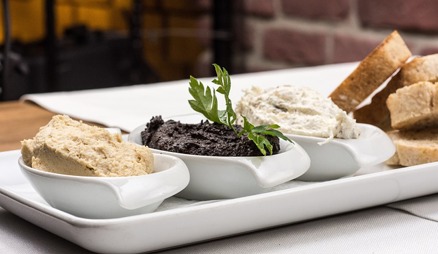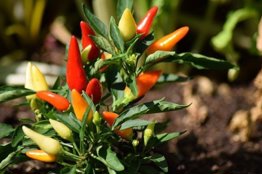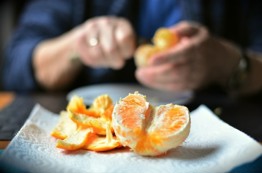Olive pomace – kedushat shevi'it in olive oil production

The olive oil preparation process generates much waste, most of which is known as olive pomace and olive mill wastewater (OMWW). Do these two byproducts have kedushat shevi'it? Plus: on uses for olive oil waste in past and present.
In Israel, olive orchards span 320,000 dunam (nearly 80,000 acres) from the Galilee to the Negev. Of them, 250,000 employ dryland farming methods while the remaining 70,000 dunam are irrigated regularly. The orchards grow approximately 80,000 tons of olives and produce some 15,000 L of olive oil and another 20,000 tons of table olives (Israel Olive Council 2021, from Zalul, an environmental NGO).
In the olive oil production process, after oil extraction, two main byproducts remain: olive pomace (also known as olive waste) and olive mill wastewater (OMWW; mei eker). Pomace is a solid residue containing skin, pulp, fragments of olives, olive kernels, and some oil remnants.
One ton (1000 kg) of olives produces approximately 200 L of olive oil (20%). The rest of it (80%) is pomace and OMWW. That is, in Israel, this comes out to roughly 60,000 kg each year.
According to most posekim, olive pomace and OMWW do not have kedushat shevi'it.
Mishnah (Shabbat 3:1) notes that olive pomace (gefet) is flammable and was used to fuel the stove:
If a stove was lit … with pomace (gefet), and with wood, [one may] not place [a pot atop it on Shabbat] until he sweeps [the coals from the stove while it is still day] or until he places ashes [on the coals, so that the fire will not ignite on Shabbat.]
In his gloss on the Mishnah, Rambam explains that pomace (which can refer also to the pulp of any other fruit or seed when liquid is extracted from them) specifically refers to olive waste: "And pomace, the olive waste left after oil is squeezed from them."
Tosefta (Shevi'it 5:19) states that olive pomace of the seventh year may be used as fuel.
Rambam rules accordingly (Shevi'it 5:19): "We may not use hay and straw of the Sabbatical year for kindling. We may, however, use the wastes of olives and grapes of the Sabbatical year for fuel."
It is forbidden to use edible materials with kedushat shevi'it as fuel. Because olive pomace, as opposed to hay and straw, is not edible for animals on its own nor is it intended as fodder (or human food), it does not have kedushah. Thus it is permissible to use it as fuel.
Even though pomace sometimes contains residual oil, because no one attempts to extract it, the pomace does not have kedushah (see below). Likewise, theoretically, pomace can be used as part of a fodder mix because pomace cannot be eaten on its own but only as part of a mixture, and also because this use is not at all common, it does not have kedushah.
Note that the Mikdash David (Rabbi David Kohen Rappaport, 1890–1942) wrote that olive pomace has kedushat shevi'it, but nevertheless it is permitted to use as fuel since it has no other use. According to this approach, the pomace needs to be handled as having kedushat shevi'it. However, the halachah does not follow his opinion.
Mishpatei Eretz (published by the Beit Midrash for Halachah in Agricultural Settlements – Emunat Ish) states that if the olives are not adequately squeezed and still contain olive oil, the pomace has kedushat shevi'it. From a conversation with Rabbi Yosef Efrati, this refers to rare cases when the olives were not squeezed properly, not to the two-phase method (see below), which likely extracts more olive oil from the olives than was possible in Mishnaic times.
The ruling of Torah VeHa'aretz Institute is that pomace does not have kedushat shevi'it since no one actually extracts the remaining oil, and only in rare cases one feeds it to animals and even then it is mixed with other additional substances before given to the animals.
Uses of olive pomace in the past
Fertilizer – Ancient Roman writings mention olive pomace used to fertilize fields.
Fuel and light – We saw in the Tosefta that pomace was used for fuel. It was necessary to dry the moist pomace in the sun. After it was dry it could be used as fuel.
Soap – During the Middle Ages in the Land of Israel, the oil remaining in the pomace (2-7%) was used to prepare soap.
Use of pomace today
Today pomace is not viewed as a resource, but rather a nuisance—waste that olive presses do not know how to deal with.
Waste removal – in most cases, pomace is disposed of in olive orchards, other orchards, fields, and open areas.
Fuel and kindling – Pomace is used as fuel for energy production and sold as briquettes and pellets for fuel in wooden stoves, fireplaces, or heaters for the garden in the private sector. The pomace is mixed and processed, compressed and dried, and turned into rolls.
Energy production – Energy production at special energy plants. This is already done in Sprain; in Israel, there is a company working on this as well.
Soap and cosmetics—Especially in small farms (see p. 64).
Fertilizer and compost – See, for example, the Meshek Tzippori farm.
Fuel – Currently studies are being conducted on the uses of pomace to produce ethanol as motor fuel.
Animal fodder – Currently studies are being conducted on using olive pomace as fodder for ruminant mammals (especially bovines). Here, the pomace is mixed with additional substances for animal feed. Note that olive pomace includes substances that may interfere with the digestive system of the animals. One recent study indicated that the product is marked by low digestibility and suitable only for non-milk-producing cows (calves, cows not yet producing milk).
See Dr. Akiva London, Use of waste (שימוש העקר), Alon Noteah 67, 2013.
Olive pomace oil – In certain countries (currently not Israel), oil remnants are extracted from the pomace through a refining process with the use of chemicals (such as hexane) and by heating the pulp mixture to an extremely high temperature. Exposure of the natural fats in the oil to extremely high heat may produce polycyclic aromatic hydrocarbons (PAHs) like benzopyrene, which research has shown to be carcinogenic (note that this is more likely for countries without regulation on PAHs). In any event, olive pomace oil is considered the lowest-grade oil and therefore is considerably less expensive than its virgin olive oil counterparts. (See Daniel Williams, "Olive pomace oil: not what you might think," The Olive Oil Times, 9 Sept., 2010).
Types of pomace
After cleaning and washing, pressing, and mixing the olives, comes the olive extraction process. There are two methods used for oil production at oil presses: two-phase and three-phase.
In the two-phase method, the olive paste is transferred to a centrifuge that extracts the oil from the paste. The pomace and wastewater come out together on one side while the oil comes out on the other side.
In the three-phase process, in the first centrifuge, the pomace is removed from the liquids, while in the second centrifuge the water is removed from the oil. The OMWW is acidic.
In the two-phase process, the remaining pomace is moist and contains oil remnants (2-7%) that are not exploited, while in the three-phase process the pomace is relatively dry.
Olive mill wastewater
Olive mill wastewater is composed of olive washing water (approximately 5% of the weight of the olives, olive pulp water (40-50% of the initial olive weight), water added to olive paste during centrifugation, and water from washing extraction plants (5-10% of the weight of processed olives). Olive mill wastewater has an adverse effect on the environment due to its highly polluting organic load. However, it does contain phenolic compounds which are rich in antioxidant properties. Therefore, these bioactive compounds have been recognized as a potential target for food, cosmetic, and pharmaceutical industries. While attempts are being made to recover these phenolic compounds and exploit them, this has not become a standard yet (Membrane Technologies for Biorefining, 2016, p. 163). For this reason, it is clear why this water does not have kedushat shevi'it, at least at this point.
Expanded sources
Mishnah (Shabbat 3:1) notes that olive pomace (gefet) is flammable and was used to fuel the stove:
|
If a stove was lit with straw or hay, it is possible to place a pot atop it. With pomace, and with wood, [one may] not place [a pot atop it on Shabbat] until he sweeps [the coals from the stove while it is still day] or until he places ashes [on the coals]. |
כירה שהסיקוה בקש ובגבבא נותנים עליה תבשיל, בגפת ובעצים לא יתן, עד שיגרוף או עד שיתן את האפר |
In his gloss on the Mishnah, Rambam explains that pomace (which can refer also to the pulp of any other fruit or seed when liquid is extracted from them) specifically refers to olive waste:
|
And pomace, the olive waste left after oil is squeezed from them. |
וגפת, פסולת הזתים שהוצא שמנן |
Furthermore, the Mishnah in Shabbat (4:1) on the prohibition of insulation (hatmanah) on Shabbat, states:
|
In what may one insulate [a pot of cooked food on Shabbat eve,] and in what may one not insulate it? One may neither insulate it in pomace, nor in manure, nor in salt, nor in lime, nor in sand … Nor in straw, nor in the residue of grapes, nor in soft material, nor in grass |
במה טומנין ובמה אין טומנין? אין טומנין לא בגפת ולא בזבל לא במלח ולא בסיד ולא בחול... לא בתבן ולא בזגים ולא במוכים ולא בעשבים |
Here, in his gloss, the Rambam extends the definition of pomace to include sesame seed pulp:
|
Pomace, we have already explained that it olive waste and also sesame seed waste. |
גפת, כבר ביארנו שהוא פסולת הזתים, וכן פסולת השומשמין |
Tosefta (Shevi'it 5:19) states:
|
It is permissible to use for fuel olive and grape pomace of the seventh year, but nut oil should not be used for lighting and olives should not be used for fuel. |
מסיקין בגפת ובזוגין של שביעית, אבל אין מדליקין באגוזין ואין מסיקין בזיתים |
Rambam rules accordingly (Shevi'it 5:19):
|
We may not use hay and straw of the Sabbatical year for kindling. We may, however, use the wastes of olives and grapes of the Sabbatical year for fuel. |
אין שורפין תבן וקש של שביעית מפני שהוא ראוי למאכל בהמה, אבל מסיקין בגפת ובזגין של שביעית |
It is forbidden to use materials with kedushat shevi'it as fuel. Because olive pomace, as opposed to hay and straw, is not edible for animals nor is it intended as fodder (or human food), it does not have kedushah and thus it is permissible to use it as fuel.
Even though moist pomace (see below) contains residual oil, because no one attempts to extract it, the pomace does not have kedushah. Likewise, while at times olive pomace can be used to prepare a fodder mix, because it cannot be eaten on its own but only as part of a mixture and also because this use is not at all common, it does not have kedushat shev'I't.
Mishpatei Eretz (22:12, n. 20) states that at olive oil mills the byproducts do not have kedushat shevi'it. However, if the olives are not squeezed thoroughly and there are oil remnants in the pomace, the pomace would have kedushat shevi'it. He adds that if one generally feeds pomace to livestock, in that case, too, the pomace would have kedushat shevi'it.
Mikdash David (59:4, s.v. katav haRambam, p. 438; Rabbi David HaKohen Rappaport, 1890-1942) innovates that olive pomace does have kedushat shevi'it but nevertheless it is permissible to use it for fuel since it cannot be used otherwise. It seems that Mishpatei Eretz (ibid.,) rejects the stringency of the Mikdash David:
Mikdash David:
|
And it seems that kedushat shevi'it applies to olive and grape pomace, which are food waste. However, it is permissible to use them as fuel since they are not worthy of other uses. Even though fuel is not considered a case where "benefit and consumption occur simultaneously," the Kessef Mishneh writes about borit and ahal (two types of aloe), that any [plant] that is not edible to humans is permissible, even when its benefit and consumption do not occur simultaneously, and in this case, we do not follow the main use of the fruit [which is for eating/oil]. |
ונראה דקדושת שביעית חלה על גפת וזגין שהן פוסלת אוכלין, וזה דמסיקין בהן הוא משום שאין ראויין לדבר אחר. ואף דהסקה חשיב אין הנאתו וביעורו שוה, הרי כתב הכסף משנה גבי בורית ואהל דכל שאינו מאכל אדם מותר אף בדבר שאין הנאתו וביעורו שוה, ובזה לא אזלינן בתר עיקר הפרי
|
The Yerushalmi (Shabbat 3:1) compares olive pomace to slow-burning wood. Thus there is a concern that one would come to stoke the coals, as opposed to straw, which burns rapidly, for which this concern does not apply.
Katif Shevi'it (5781) 19:39:
|
It is possible to press olives to produce olive oil. The pomace and water left after olives are pressed and the oil is extracted do not have kedushat shevi'it since they are not used for food or for additional pressing. Therefore, it is possible to use them for various needs, such as fertilizing the soil.
|
ניתן לכתוש זיתים לשם הפקת שמן זית. בגפת ובמים שנותרים לאחר עצירת השמן והפרדתו אין קדושת שביעית, מכיוון שהם אינם משמשים למאכל או לסחיטה נוספת של השמן, וניתן להשתמש בהם לצרכים שונים, כדישון הקרקע |
Rabbi Yehuda Amichay writes as follows:
|
Today olive pomace is not designated for use as animal fodder. Thus it may be used as fertilizer after shemitah, since it is devoid of kedushat shevi'it. |
גפת בימינו איננה עומדת לאכילת בהמה, ועל כן אפשר יהא לדשן בה לאחר השביעית, שהרי אין בה קדושת שביעית |
Expansion on animal manure
The Gemara deliberates about the status of manure and concludes that the droppings of sheep and goats (beheimah dakah, lit. small livestock) are similar to olive pomace, which burns slowly, while manure of large livestock (beheimah gasah) are comparable to straw that burns rapidly. Alternatively, it is possible that the intent of "small" and "large" refer to the manure itself. See Korban Ha'eidah. Some maintain that the opposite is true: the manure of small livestock is comparable to straw while that of large livestock is like olive pomace; see Pnei Moshe.
The Yerushalmi (Shabbat 3:1) discusses if manure can be compared to straw and hay on Shabbat which are consumed rapidly, so there is no concern that one would stoke the fire. Or, if manure is similar to olive pomace and wood, which burns slowly, in which case there is a concern that one would come to stoke the fire:
Yerushalmi Shabbat 3:1:
|
Animal excretions – there are Ta'anim who learn that it is similar to pomace and wood, and some Tana'im learn that it is similar to straw and hay. Those who say that small [livestock/manure] is similar to pomace and wood, and those who say it is like straw and hay [refer to] large [livestock/manure.] |
גללי בהמה אית תניי תני כגפת וכעצים ואית תניי תני כקש וכגבבה. מאן דמר כגפת וכעצים בדקה. ומאן דמר כקש וכגבבה בגסה |
Korban Ha'eidah, Shabbat 3:1
|
Gelalei beheimah. This is the excretion of cattle. |
גללי בהמה. הן צפיעי בקר |
Penei Moshe Shabbat 3:1
|
"Animal excretions." That one used for fuel, "there are Tana'im who learn, etc." And as the Gemara states, there is no disagreement that pomace and wood are similar to large livestock, whose manure is hard and many, such as that of a horse, and he who said it is like straw and hay, when it is from small livestock since they are soft and they do not form coals. And in printed books, the words ["large" and "small"] were switched. |
גללי בהמה. שהסיק בהן אית תניי תני וכו'. וקאמר הש"ס דלא פליגי דמ"ד שהן כגפת וכעצים בבהמה גסה שהגללים שלה קשים והרבה הן כגללי סוס ומ"ד כקש וכגבבא אם הן מבהמה דקה שהן רכים ואין גחלים מהן ובספרי הדפוס נתחלפו התיבות |




